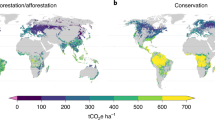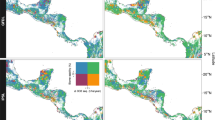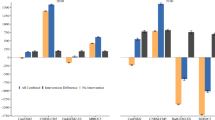Abstract
Terrestrial ecosystems regulate climate through both biogeochemical (greenhouse-gas regulation) and biophysical (regulation of water and energy) mechanisms1,2. However, policies aimed at climate protection through land management, including REDD+ (where REDD is Reducing Emissions from Deforestation and Forest Degradation)3 and bioenergy sustainability standards4, account only for biogeochemical mechanisms. By ignoring biophysical processes, which sometimes offset biogeochemical effects5,6, policies risk promoting suboptimal solutions1,2,4,7,8,9,10. Here, we quantify how biogeochemical11 and biophysical processes combine to shape the climate regulation values of 18 natural and agricultural ecoregions across the Americas. Natural ecosystems generally had higher climate regulation values than agroecosystems, largely driven by differences in biogeochemical services. Biophysical contributions ranged from minimal to dominant. They were highly variable in space, and their relative importance varied with the spatio-temporal scale of analysis. Our findings reinforce the importance of protecting tropical forests7,10,12,13, show that northern forests have a relatively small net effect on climate5,10,13, and indicate that climatic effects of bioenergy production may be more positive when biophysical processes are considered14,15. Ensuring effective climate protection through land management requires consideration of combined biogeochemical and biophysical processes7,8. Our climate regulation value index serves as one potential approach to quantify the full climate services of terrestrial ecosystems.
This is a preview of subscription content, access via your institution
Access options
Subscribe to this journal
Receive 12 print issues and online access
$209.00 per year
only $17.42 per issue
Buy this article
- Purchase on Springer Link
- Instant access to full article PDF
Prices may be subject to local taxes which are calculated during checkout



Similar content being viewed by others
References
Bonan, G. B. Forests and climate change: Forcings, feedbacks, and the climate benefits of forests. Science 320, 1444–1449 (2008).
Chapin, F. I., Randerson, J., McGuire, A., Foley, J. & Field, C. Changing feedbacks in the climate–biosphere system. Front. Ecol. Environ. 6, 313–320 (2008).
UNFCCC Report on the Conference of the Parties on its Thirteenth Session, Held in Bali from 3 to 15 December 2007. Part Two: Action Taken by the Conference of the Parties at its Thirteenth Session 8–10 (United Nations, 2008).
Anderson-Teixeira, K. J., Snyder, P. K. & DeLucia, E. H. Do biofuels life cycle analyses accurately quantify the climate impacts of biofuels-related land use change? Illinois Law Rev. 2011, 589–622 (2011).
Betts, R. A. Offset of the potential carbon sink from boreal forestation by decreases in surface albedo. Nature 408, 187–190 (2000).
Costa, M. H. & Foley, J. A. Combined effects of deforestation and doubled atmospheric CO2 concentrations on the climate of Amazonia. J. Clim. 13, 18–34 (2000).
Jackson, R. B. et al. Protecting climate with forests. Environ. Res. Lett. 3, 044006 (2008).
Pielke, R. A. et al. The influence of land-use change and landscape dynamics on the climate system: Relevance to climate-change policy beyond the radiative effect of greenhouse gases. Phil. Trans. R. Soc. Lond. A 360, 1705–1719 (2002).
Betts, R. Implications of land ecosystem–atmosphere interactions for strategies for climate change adaptation and mitigation. Tellus B 59, 602–615 (2007).
Arora, V. K. & Montenegro, A. Small temperature benefits provided by realistic afforestation efforts. Nature Geosci. 4, 514–518 (2011).
Anderson-Teixeira, K. J. & DeLucia, E. H. The greenhouse gas value of ecosystems. Glob. Change Biol. 17, 425–438 (2011).
Gullison, R. E. et al. Tropical forests and climate policy. Science 316, 985–986 (2007).
Betts, R. A. Climate science: Afforestation cools more or less. Nature Geosci. 4, 504–505 (2011).
Loarie, S. R., Lobell, D. B., Asner, G. P., Mu, Q. & Field, C. B. Direct impacts on local climate of sugar-cane expansion in Brazil. Nature Clim. Change 1, 105–109 (2011).
Georgescu, M., Lobell, D. B. & Field, C. B. Direct climate effects of perennial bioenergy crops in the United States. Proc. Natl Acad. Sci. USA 108, 4307–4312 (2011).
Feddema, J. J. et al. The importance of land-cover change in simulating future climates. Science 310, 1674–1678 (2005).
Albani, M., Medvigy, D., Hurtt, G. C. & Moorcroft, P. R. The contributions of land-use change, CO2 fertilization, and climate variability to the Eastern US carbon sink. Glob. Change Biol. 12, 2370–2390 (2006).
Pan, Y. et al. A large and persistent carbon sink in the world’s forests. Science 333, 988–993 (2011).
Herzog, T. World Greenhouse Gas Emissions in 2005 WRI Working Paper (2009); available at http://www.wri.org/publication/navigating-the-numbers.
IPCC Climate Change 2007: The Physical Science Basis (eds. Solomon, S. et al.) (Cambridge Univ. Press, 2007).
West, P. C., Narisma, G. T., Barford, C. C., Kucharik, C. J. & Foley, J. A. An alternative approach for quantifying climate regulation by ecosystems. Front. Ecol. Environ. 9, 126–133 (2011).
Snyder, P. K., Delire, C. & Foley, J. A. Evaluating the influence of different vegetation biomes on the global climate. Clim. Dynam. 23, 279–302 (2004).
Twine, T. E., Kucharik, C. J. & Foley, J. A. Effects of land cover change on the energy and water balance of the Mississippi river basin. J. Hydrometeorol. 5, 640–655 (2004).
Searchinger, T. et al. Use of US croplands for biofuels increases greenhouse gases through emissions from land-use change. Science 319, 1238–1240 (2008).
Foley, J. A., Levis, S., Prentice, I. C., Pollard, D. & Thompson, S. L. Coupling dynamic models of climate and vegetation. Glob. Change Biol. 4, 561–579 (1998).
Kucharik, C. J. Evaluation of a process-based agro-ecosystem model (Agro-IBIS) across the US Corn Belt: Simulations of the interannual variability in maize yield. Earth Interact. 7, 1–33 (2003).
Vanloocke, A., Bernacchi, C. J. & Twine, T. E. The impacts of Miscanthus ×giganteus production on the Midwest US hydrologic cycle. GCB Bioenergy 2, 180–191 (2010).
Cuadra, S. V. et al. A biophysical model of sugarcane growth. GCB Bioenergy 4, 36–48 (2012).
Kucharik, C. J. et al. Testing the performance of a dynamic global ecosystem model: Water balance, carbon balance, and vegetation structure. Glob. Biogeochem. Cycles 14, 795–825 (2000).
Marland, G. et al. The climatic impacts of land surface change and carbon management, and the implications for climate-change mitigation policy. Clim. Policy 3, 149–157 (2003).
Acknowledgements
This research was funded by the Energy Biosciences Institute and the BP Energy Sustainability Challenge Program. The authors acknowledge A. VanLoocke for his contributions to modelling biophysical factors for grasslands and crops.
Author information
Authors and Affiliations
Contributions
K.J.A-T., P.K.S. and E.H.D. conceived the experiment; K.J.A-T., P.K.S., T.E.T., M.H.C. and S.V.C. contributed models; K.J.A-T. compiled biogeochemical data and calculated GHGVs; P.K.S., T.E.T. and S.V.C. ran IBIS/AgroIBIS simulations; K.J.A-T. and P.K.S. analysed data and prepared figures; K.J.A-T. wrote the paper; all authors commented on the analysis and presentation of the data and revised the paper.
Corresponding author
Ethics declarations
Competing interests
The authors declare no competing financial interests.
Supplementary information
Rights and permissions
About this article
Cite this article
Anderson-Teixeira, K., Snyder, P., Twine, T. et al. Climate-regulation services of natural and agricultural ecoregions of the Americas. Nature Clim Change 2, 177–181 (2012). https://doi.org/10.1038/nclimate1346
Received:
Accepted:
Published:
Issue Date:
DOI: https://doi.org/10.1038/nclimate1346
This article is cited by
-
The interactions among landscape pattern, climate change, and ecosystem services: progress and prospects
Regional Environmental Change (2023)
-
Albedo changes caused by future urbanization contribute to global warming
Nature Communications (2022)
-
Background climate conditions regulated the photosynthetic response of Amazon forests to the 2015/2016 El Nino-Southern Oscillation event
Communications Earth & Environment (2022)
-
Impact and trade off analysis of land use change on spatial pattern of ecosystem services in Chishui River Basin
Environmental Science and Pollution Research (2022)
-
Prioritizing forestation based on biogeochemical and local biogeophysical impacts
Nature Climate Change (2021)



